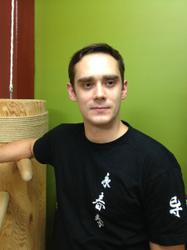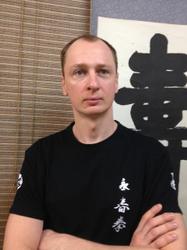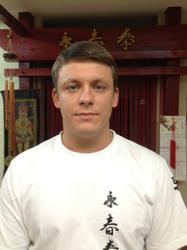Wing Chun Symbols
The Wing Chun School has a well developed system of symbols. It includes an emblem, a hieroglyphic sign of the school’s name, a welcoming gesture and a motto.
 The flower of the wild plum plant (with five petals and eight stamens), as seen in illustration 1, has been adopted as the school’s official emblem. This was the emblem of the Great Master Yip Man (Ye Ven), Hong Kong, 1960.
The flower of the wild plum plant (with five petals and eight stamens), as seen in illustration 1, has been adopted as the school’s official emblem. This was the emblem of the Great Master Yip Man (Ye Ven), Hong Kong, 1960.
Chinese tradition tells us that the blossoming wild plum Mei’ is the main symbol of Spring (not to be confused with the domestic plum). Its flowers blossom ahead of all others. Its flowers emerge even before its own leaves appear, often before the snow has melted completely. This image has been especially adored and portrayed by poets and artists since a very long time ago. In Taoist philosophy, it stands for the overcoming of the strong’ (Yin) by the weak and newly born (Yan). It is hard to find a more appropriate emblem for the Eternal Spring style and its philosophy of the weak overcoming the strong. In addition, the name of the school’s founder, Ng Mui (pronounced U Mei’ in its official Putunhua dialect) means Five Wild Plums’.
In the Wing Chun tradition, which is a little different from more common Chinese cultural traditions, the five petals symbolise five of nature’s elements (or, more precisely, the five types of natural energy) and the eight stamens, eight trigrams (Ba-gua). A picture emerges of the interaction of nature’s energy (usin). This comprises of water (shui), wood (mu), fire (huo), earth (t’u) and metal (chin). This is one of the fundamental principles of the whole Chinese world outlook. In the Usin system, the five primary elements match the five colours of the primary gamma (black, blue-green (tsin in Chinese), red, yellow and white). By mixing these, all other colours and tones can be created as can five keys of traditional Chinese music, five solid and five hollow organs of Chinese medicine, five tastes of Chinese kitchen, five types of traditional aroma, five sense organs (sight, hearing, smell, sense of touch and taste). Through the senses a human understands the fullness of the surrounding world. Sight recognises the five colours. Hearing recognises the five musical keys. Smell recognises the five aromas. The sense of touch (with the help of the pulse diagnostic) recognises the five solid and five hollow organs. Taste reveals the five various tastes.
That is why, during Wing Chun School classes, special attention is afforded to a deep and harmonic development of the sense organs. This is one of the reasons why, in Vietnam, Wing Chun is considered to be a pursuit for the elite. Artists, musicians, doctors, scientists (the power players of our world) make up a significant number of those studying this style. The majority of these go on to achieve success in this chosen path.
The Eight Trigram (Ba-gua) is yet another fundamental principle of the Chinese tradition. In accordance with the classic Book of Changes (I Ching) and with the help of Gua, a global world view can be described, including current or future aspects, which cannot be sensed with the senses or even by intellectual efforts. In the past, among Confucianist theorists, it had been believed that the deep study of this canon is for people who were exceptionally gifted, those with a clear heart and mind. Following the Ba-gua system in Wing Chun School, special forms were developed, as were combinations of technical exercises, so too combat tactics and strategies. Other important qualities of Eternal Spring followers (previewing and predicting) were, at the same time, developed.
 Currently, as Wing Chun becomes more diversified throughout the world, its proponents often move from the natural flower image towards the symbolic illustration of the five energy types (as can be seen in diagram number 2: by S. Barchevskiy, 1994. Emblem of Zheleznaya Fleita Club of Moscow’s Wing Chun School, led by V.V. Martynov).
Currently, as Wing Chun becomes more diversified throughout the world, its proponents often move from the natural flower image towards the symbolic illustration of the five energy types (as can be seen in diagram number 2: by S. Barchevskiy, 1994. Emblem of Zheleznaya Fleita Club of Moscow’s Wing Chun School, led by V.V. Martynov).
As once remarked to the author during a private talk with Chan Hou Tuan (a well known Vietnamese artist and great Wing Chun expert): “I was stunned to see this sign. The reason is that I have been working on an emblem for our school in Vietnam for more then two years already. But, so far, I haven’t arrived at a satisfactory result. And here the idea of the five natural elements is illustrated very well. They are totally different from one another. Each one has its own character, its own energy. It has its own animal style and unique combat manner.”
 Developing the flower image in the 70s and 80s the protagonists used to add an image of a crossed pair of Bart Cham Dao’ knives to the school’s existing symbol. These knives were a symbol of Wing Chun’s applied character, but are now used less and less. The full name of the school in the Chinese dialect is Vin Chun Kuen. In the Putonghua dialect it is Yun Chun Quan and, in Vietnamese, Vin Suan Quen). (Picture 3).
Developing the flower image in the 70s and 80s the protagonists used to add an image of a crossed pair of Bart Cham Dao’ knives to the school’s existing symbol. These knives were a symbol of Wing Chun’s applied character, but are now used less and less. The full name of the school in the Chinese dialect is Vin Chun Kuen. In the Putonghua dialect it is Yun Chun Quan and, in Vietnamese, Vin Suan Quen). (Picture 3).
It is usually translated as Eternal Spring’ or the School of Eternal Spring’. It is often simply replaced with a sign’ with the same pronunciation but read in a singsong manner, praised in poems’ (page 4).
Some interpreters with a dictionary’ managed to translate it as Fist of the Spring Praising’. The last hieroglyph can be written several different ways, which makes it even more confusing!
 Several Masters think that, today, Wing Chun has already outgrown the boundaries of one style and, so, prefer to use Wing Chun Pai (that’s Wing Suan Phai in Vietnemese), which means Branch of Eternal Spring or Eternal Spring Group of Schools.
Several Masters think that, today, Wing Chun has already outgrown the boundaries of one style and, so, prefer to use Wing Chun Pai (that’s Wing Suan Phai in Vietnemese), which means Branch of Eternal Spring or Eternal Spring Group of Schools.
The School’s unique welcoming originates from a secret gesture used by warriors against the Manchu. It was also previously copied from Shaolin monks and altered slightly. From the 1860s and certainly since its inception, Wing Chun had been closely allied to the secret societies and followers of the later overthrown Ming Dynasty. Under-grounders’ had a complicated system of conspiracy including a special greeting, i.e. a folded fist and an open palm. The hidden meaning of this gesture is: a clenched left fist symbolises the moon: an open right palm, the sun. The hieroglyph Zhi (sun) and Ue (moon) together make the sign Ming – meaning clearness, light’. It also signifies the Ming Dynasty.
Guan (light, to shine; to radiate light, to shine)
I (exclamatory particle in literary language)
Er (adverse conjunction …, but...)
Bu (adverse particle No)
Yao (to glare, to shimmer, to glitter (in all meanings). One known saying is Yao U Yan Vei’, meaning to shine with a weapon showing power’)

A philosophical interpretation of this image is: the Sun as a symbol of active Yan strength and the Moon as the unresisting strength of Yin. The Wing Chun warrior turns a contender’s strength against himself in the same way that the moon uses its Yan energy to reflect sunlight away. In respect of martial arts, the greeting gesture is symbolises a block’ and a hit’ simultaneously. The block and the hit is a singularity. It is a fundamental principle of Wing Chun martial arts. The greeting gesture is the first martial arts technique learned by Eternal Spring beginners.
Wing Chun’s motto is: Bright without glare’. The Master Hoan Wing Zang explains it as follows: The mind’s light needs clarity, needs to be understood. Otherwise it will only blind your eyes’. In its physical nature, light is a wave. Human sight has the unique ability, aided by reflected light waves, to sense the world around us. An attempt to look at the sun, the desire to see it directly (not just its reflected light) would blind us. The ancient principle of a wave, moving along a wave, the prior perception of the contender’s action along the wave, the energy transmission along the wave’ may be viewed in a similar fashion. In Wing Chun all of these are directly linked with modern physics. It is highly probable that the school’s motto dates back to the Taoist canon Chuan Chi’. A phrase like this one (according to L. Pozdneyeva’s translation) can be seen in chapter 15 of his book, along with other epithets for the perfect Taoist. The author, K. Ageyev, uncovered this ancient text especially for his leading article and added calligraphic lettering with his new translation. (Picture 5).
Shines! But does not blind [with glare]



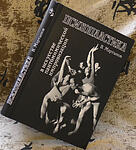

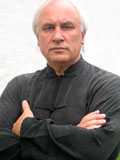 Коан – вопрос к членам Федерации Юн Чун Цюань от президента В.В. Мартынова: «Что Вы сделали для Федерации из того, что не мог бы сделать любой другой за деньги?»
Коан – вопрос к членам Федерации Юн Чун Цюань от президента В.В. Мартынова: «Что Вы сделали для Федерации из того, что не мог бы сделать любой другой за деньги?»
